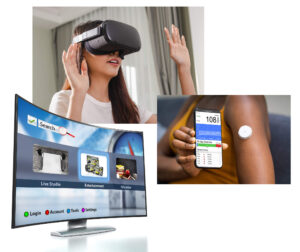Printed electronics is poised to change the playing field in many industries. If you haven’t heard of it before, chances are you soon may.
In a nutshell, printed electronics is the technology of printing computer circuits on flexible materials using special metallic inks. Whether it’s paper, plastic, cloth, or some exotic material—if you can print on it, you can turn it into a computer device.
Now, after years of research, practical applications and products are beginning to hit the market, from medical devices and flexible OLED displays, to IoT sensors and next-generation automotive and A&D manufacturing, to augmented reality, virtual reality, and many others.

A number of practical applications will now be possible.
To move into full production mode, all of these products need a way to sinter, or cure, the metallic inks at high speed to keep up with the roll-to-roll (R2R) printing presses. That’s where Pulsed Light comes in, and the latest news from a leading university research lab is very good.
Fast sintering just got faster
It’s been known for some time that Pulsed Light is able to sinter inks faster than other methods. That’s because it delivers high energy in rapid pulses, without generating heat that could harm the material being printed on.
Now, researchers at Northwestern University have reported a modified method that enhances the Pulsed Light sintering process even further. In their experiment, the researchers added the polymer nitrocellulose to the inks. They found that nitrocellulose increases combustion activity during sintering, resulting in 60% more electrical conductivity. The researchers concluded:
 “…combustion-assisted photonic sintering (CAPS)… is two orders of magnitude faster than previously demonstrated noncontact sintering techniques. CAPS provides a pathway for… high-throughput additive manufacturing of flexible electronics.”
“…combustion-assisted photonic sintering (CAPS)… is two orders of magnitude faster than previously demonstrated noncontact sintering techniques. CAPS provides a pathway for… high-throughput additive manufacturing of flexible electronics.”
In other words, printed electronics is ready for mass production, and some interesting applications could be on the way.
What to look for
Recently, printedelectronicsnow.com asked several experts in the industry what applications they see coming in the near future. Klaus Heckler, managing director of OE-A, an industry organization, said that key applications are in the areas of healthcare, automotive, consumer electronics, and building & architecture. Here are some of the specific applications the experts cited:
- Smart packaging for foods and pharmaceuticals to track and monitor safety.
- E-textiles for biomedical devices such as glucose test strips or monitoring of patients. E-textiles offer flexibility, improved accuracy, and comfort for the wearer.
- Micro-LED lighting that can be deployed almost anywhere.
- Applications at the edge of the IoT, such as asset tracking, structural health monitoring, and infrastructure/agricultural sensors. Low-cost sensors will make these vital applications much more affordable.
- Capacitive switches, which are found in just about every device or machine we use. With printed electronics, these circuits can be made smaller and for less cost than with other solutions, while providing greater product design freedom—an important consideration in many markets.
Some exciting consumer-oriented products are on the horizon, too, like flexible screens that fold or roll up. Another market is intelligent wearables and patches that could be used with AR and VR to enhance the immersive experience, whether for industrial applications or consumer entertainment.
These are just some of the innovative products we can expect to see from printed electronics. The technology has the potential to improve everything from simple conveniences to life-enhancing health and safety innovations.
XENON is the partner you need
Printed electronics is a game-changing technology, and XENON is positioned to take this technology into the future. An innovator and leader in sintering solutions for printed electronics, XENON offers both production systems and benchtop units designed and priced specifically for R&D. These systems are used by many university and commercial labs around the world.
XENON’s decades of experience and array of resources are ready to support researchers and product developers on the forefront of this industry. If you’d like to learn more, click here or contact us today.
